
The Oxford Canal is a 78-mile (126 km) narrowboat canal in central England linking the City of Oxford with the Coventry Canal at Hawkesbury via Banbury and Rugby. Completed in 1790, it connects to the River Thames at Oxford, and links with the Grand Union Canal, which it is combined with for 5 miles (8 km) between to the villages of Braunston and Napton-on-the-Hill.

The Coventry Canal is a navigable narrow canal in the Midlands of England.

The Galton Bridge is a cast-iron bridge in Smethwick, near Birmingham, in central England. Opened in 1829 as a road bridge, the structure has been pedestrianised since the 1970s. It was built by Thomas Telford to carry a road across the new main line of the Birmingham Canal, which was built in a deep cutting. The bridge is 70 feet above the canal, making it reputedly the highest single-span arch bridge in the world when it was built, 26 feet wide, and 150 feet long. The iron components were fabricated at the nearby Horseley Ironworks and assembled atop the masonry abutments. The design includes decorative lamp-posts and X-shaped bracing in the spandrels.
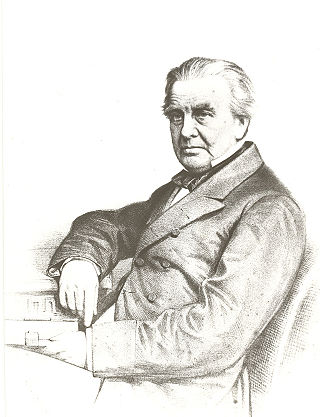
Charles Blacker Vignoles was an influential British railway engineer, and eponym of the Vignoles rail.
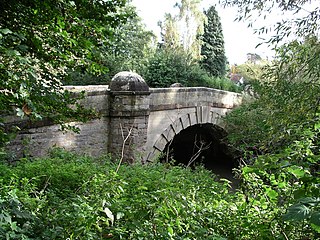
The River Sherbourne is a river that flows under the centre of the city of Coventry, in the West Midlands, in England.
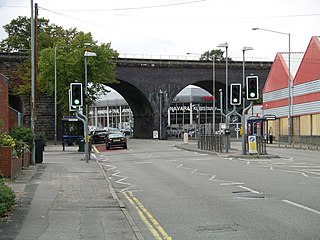
Spon End is a suburb of Coventry, England. It is situated west of Coventry city centre. The Butts Park Arena and a Premier Inn hotel are situated on the main road through Spon End. The Butts Park Arena, which was opened in 2004, is the home of Coventry Rugby Football club. Coventry Bears rugby league club and Coventry United and Coventry United L.F.C. football clubs are tenants of Coventry Rugby club and also play at Butts Park Arena where an all-weather pitch has been installed. Coventry Bears rugby league club were tenants until 2022.
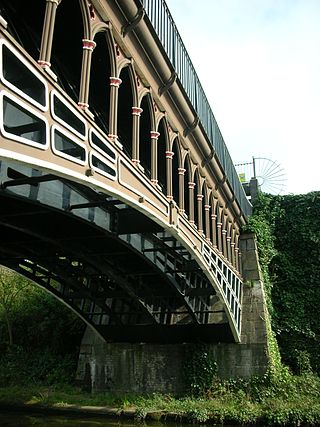
The Engine Arm Aqueduct near Smethwick, West Midlands, England, was built in 1825 by Thomas Telford to carry a water feeder, the Engine Arm, from Edgbaston Reservoir over the BCN New Main Line canal to the adjacent and parallel Old Main Line. It is a Scheduled Ancient Monument and is Grade II* listed.
The BCN Main Line, or Birmingham Canal Navigations Main Line is the evolving route of the Birmingham Canal between Birmingham and Wolverhampton in England.

Smethwick Junction is the name of the canal junctions where the Birmingham Canal Navigations Main Line Canal from Birmingham splits into the BCN Old Main Line and the BCN New Main Line near to Smethwick, West Midlands, England.
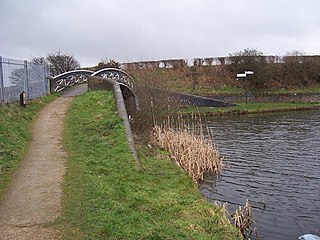
Ogley Junction, on the Staffordshire county border near Brownhills, West Midlands, England, is a historic canal junction on the Wyrley and Essington Canal where the Anglesey Branch left the main line.
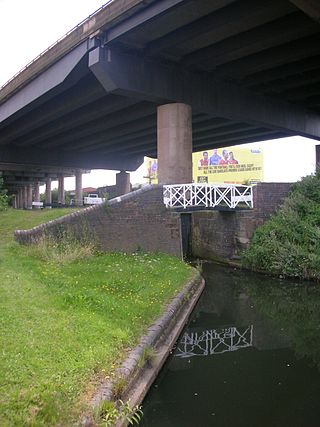
Spon Lane Junction is the original junction of the Wednesbury Canal and the Birmingham Canal, near Oldbury in the West Midlands, England.
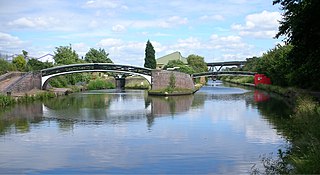
Bromford Junction is a canal junction at the foot of the Spon Lane Locks where the Spon Lane Locks Branch meets the BCN New Main Line near Oldbury in the West Midlands, England.
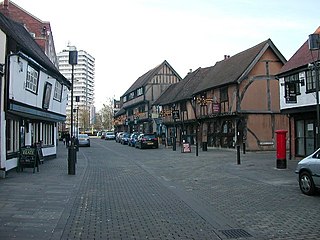
Spon Street is an historic street in central Coventry, in the West Midlands of England. The street was once part of a route that ran from Gosford to Birmingham – a route which remained intact until the 1960s. During the construction of Coventry's Inner Ring Road, built to relieve traffic on the narrow city centre streets, Spon Street was cut in half and the route severed.

There are ten scheduled monuments in Coventry. In the United Kingdom, a scheduled monument is a "nationally important" archaeological site or historic building that has been given protection against unauthorised change by being placed on a list by the Secretary of State for Digital, Culture, Media and Sport; English Heritage takes the leading role in identifying such sites. Monuments are defined in the Ancient Monuments and Archaeological Areas Act 1979 and the National Heritage Act 1983. Scheduled monuments—sometimes referred to as scheduled ancient monuments—can also be protected through listed building procedures, and English Heritage considers listed building status to be a better way of protecting buildings and standing structures. A scheduled monument that is later determined to "no longer merit scheduling" can be descheduled.

The Charterhouse, Coventry is a grade I listed building on London Road, Coventry, in the West Midlands of England.
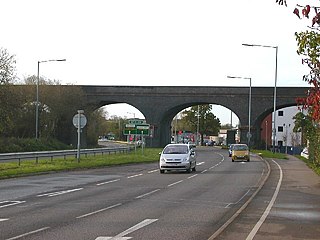
The Midland Counties Railway viaduct is a disused railway viaduct at Rugby, Warwickshire, which crosses over both the A426 Rugby to Leicester road, and the River Avon to the north of Rugby town centre.

The Sherbourne Viaduct is a railway bridge that carries the Birmingham Loop line across the River Sherbourne in Coventry, central England. Built in 1838, it is a grade II listed building.

Spon End Viaduct is a railway bridge which spans the River Sherbourne in Spon End, just west of the city centre of Coventry in central England.

Spon Bridge is a bridge carrying Spon Street across the River Sherbourne in Coventry, central England.

Hampton in Arden packhorse bridge crosses the River Blythe near Hampton in Arden in the West Midlands of England, between Birmingham and Coventry. Dating from the 15th century, it is the only bridge of its kind in the area now covered by the West Midlands, and is a grade II* listed building and a scheduled monument.




















